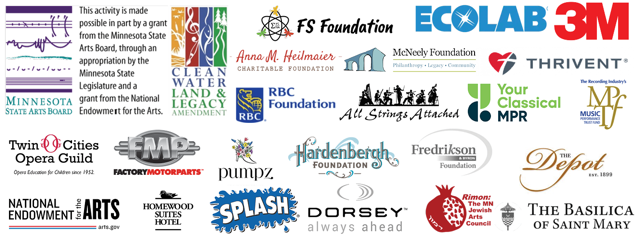Please click here for COVID-related updates
Farewell Concerts
Fri. Oct 18 First Covenant Church 7pm
1280 Arcade Street, St. Paul, 55106
Sun. Oct 20 Basilica of St. Mary 2pm
1600 Hennepin Avenue, Minneapolis, 55403
Program
Overture on Hebrew ThemesSergei Prokofiev
Symphony No 35 in D Major, K. 385, “Haffner”Wolfgang Amadeus Mozart
Symphony No. 3 in a minor, “Scottish”Felix Mendelssohn
Program Notes
Overture on Hebrew ThemesSergei Prokofiev (1891-1953)
Sergei Prokofiev was born in the Ukraine (Russia) in 1891 and died in Moscow in 1953. In between he spent time in Paris and the United States. His music is known for whit, sarcasm and a lyricism that always seems fresh and stimulating. He had a unique approach to harmony – constantly changing keys in unexpected manners and times – and because of this, one can clearly identify his music.
The Overture on Hebrew Themes was originally composed for some friends who at the time were living in New York but were former fellow students with him at St. Petersburg. The friends were all Jewish and had formed a chamber music group called Zimro. The instrumentation of the group was clarinet, piano and string quartet, and their concerts were a combination of duos, trios and quartets. They asked Prokofiev to use some Hebrew themes (they gave him a notebook filled with suggestions) to create an overture using all the players, so that they could open their concerts as a full ensemble. Prokofiev was reticent at first, as he preferred to work only with original material. But after leafing through the notebook, he found some tunes that he liked, and in one day sketched out the overture. Ten days later, a finished score was presented, and the first performance of this chamber version took place in 1920.
In 1934, Prokofiev took the material and filled out the instrumentation to a full orchestra version. Because the word “Jewish” appeared in the title, performances were very rare in antisemitic Russia. In the 1970s, a performance by the Moscow State Philharmonic was scheduled, but almost had to be canceled because of the title. A compromise was reached by simply calling the piece “Overture, opus 34” and leaving out references to “Jewish.” However, word leaked out that this was the “Jewish overture” and, consequently, the hall was packed and the performance a smashing success. jf
Symphony No 35 in D Major, K. 385, “Haffner”Wolfgang Amadeus Mozart (1756-1791)
Much has been written about Mozart the “boy genius,” his remarkable musical creations, and his many ups and downs both financially and personally. Today, when one thinks about Mozart, invariably it is about his musical creations, whether they be his 27 piano concertos, five violin concertos, 41 symphonies, 22 operas (ten of which he composed as a teenager), or the enormous amount of chamber music. One can readily forget that his day-to-day life could be both exhilarating and, at the same time, filled with stress and anxiety.
Mozart’s last six symphonies are generally considered to be his best. The first of these works, the Haffner, was composed in 1782. The last three symphonies were written during the summer of 1788, just 3 years before his death.
In 1776, Mozart was commissioned to compose a serenade for the wedding of a family friend, Sigmund Haffner. Haffner was the mayor of Salzburg, and helped support Mozart’s European tours. Later, Haffner’s son was awarded with an aristocratic title, and more music was requested. The result was a new serenade that became known as the Haffner Serenade, a six-movement composition that reflected the festive nature of the occasion.
In December of 1782, Mozart was going to present this new serenade in concert and asked his father to send him the score and parts. Later, in February of 1783, Mozart needed music to present for an upcoming concert series. He was short on time, and so started looking at the second serenade as a possibility. He dropped two of the original movements – a march and a minuet – added a few winds to fill out the orchestration, and with that created his Haffner Symphony. When he finished the work, he wrote to his father:
My new Haffner symphony has positively amazed me, for I had forgotten every single note of it. It must surely produce a good effect…”
The performance of the “new” symphony was very successful, and in a letter to his father, Mozart wrote:
The theater could not possibly have been more crowded, and all the boxes were taken… But what pleased me most was that His Majesty the Emperor was there too, and that he was so pleased, and what loud applause he gave me… It is his custom to send the money to the box office before he comes to the theater, otherwise I might really have expected more from him, for his satisfaction was boundless.
This truly is an amazing work, and what I find most intriguing is that Mozart completely forgot about it. When one considers all the magnificent music he created, and at such a consistently fast pace, maybe one can understand, but still…. jf
Symphony No. 3 in a minor, “Scottish”Felix Mendelssohn (1809-1847)
Felix Mendelssohn was a very gifted and lucky individual. His genius for music was recognized at a young age, and his parents encouraged his studies and musical performance. His parents invited many of the great performers to come to their home for regular chamber music sessions, thereby affording the young Felix and his sister Fanny (who was also a very talented performer and composer) opportunities to be surrounded by and perform with some of the leading musicians of the times.
Throughout his career, Mendelssohn composed for nearly all genres – piano and other chamber music, voice, symphonies, and major choral works. He was also instrumental in resurrecting works by other (sometimes forgotten) composers, including non other than J. S. Bach.
In 1829, while traveling to London, Felix took a side trip to Scotland and the Hebridean Island of Staffa. He was so taken with the scenery that it became the inspiration for the Fingal’s Cave Overture. Also while in Scotland, he visited the Holyrood Castle, where he jotted down some 51 bars – a melody which eventually became the basis for the slow introduction to his fifth and final symphony.
Between 1830 and 1833, Mendelssohn composed his last three great symphonies: the Reformation, Italian, and the Scottish. Interestingly, the numbering of these three works was reversed, as the last two symphonies were published after Mendelssohn’s death. All three works have a program, describing their subject matter in musical terms. The Scottish Symphony is reminiscent of the Scottish countryside and of the Holyrood Castle, where, as Mendelssohn wrote:
We went to the Palace where Queen Mary lived and loved; there is a little room to be seen there with a staircase at its door; they went up that and found Rizzio in the little room, dragged him out, and three chambers away there is a dark corner where they murdered him. The chapel beside it has now lost its roof, it is overgrown with grass and ivy, and at the broken altar Mary was crowned Queen of Scotland. Everything is ruined, decayed, and open to the sky. I believe I have found there today the beginning of my Scotch Symphony…
Similar to the violin concerto, this Symphony was conceived as a continuous entity, with little or no interruption between the movements. It was completed in 1842 and had its first performance in Leipzig. Later, after the London premiere, Mendelssohn dedicated the symphony to Queen Victoria, who, with her husband Albert, were great admirers of the composer and his music. jf

